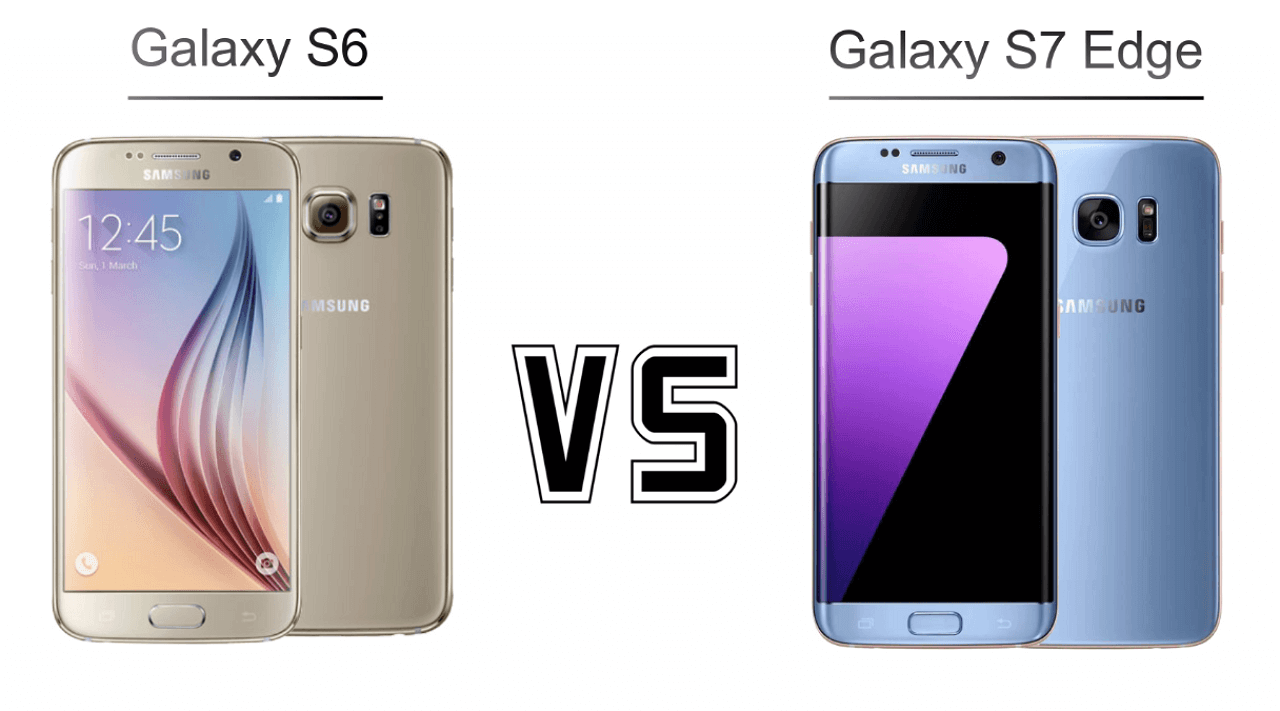If you own the Samsung Galaxy S6 smartphone but want to upgrade it to the new Samsung Galaxy S7 Edge smartphone? If yes, and if you are confused between these two smartphones and looking for a comparison of both Samsung smartphones, then you are at the right place.
Here we have mentioned the comparison between the Samsung Galaxy S6 and Samsung Galaxy S7 Edge. So, find out whether or not the Samsung Galaxy S7 Edge smartphone can beat the Galaxy S6 smartphone.
The Samsung Galaxy S6 smartphone was launched in March 2015 with a 5.1-inch touchscreen display. On the other hand, the Samsung Galaxy S7 Edge smartphone was launched in February 2016 with a large 5.5-inch dual Edge Super AMOLED display. The Display of both these smartphones comes with a QHD (2560 x 1440p) resolution. So, here in terms of display resolution, there are no changes.
Only in the Samsung Galaxy S7 Edge will you find the New Dual Edge Display, which is not available in the Galaxy S6 smartphone. In terms of software, the Samsung Galaxy S6 smartphone runs on a TouchWiz UI which is based on Google’s Android v5.0 Lollipop Operating system. But on the Samsung Galaxy S7 Edge, you will find the latest Google’s Android 7.1.0 Nougat operating system.
Samsung Galaxy S6 vs S7 Edge
Samsung Galaxy S6 vs S7 Edge Comparison Chart
| Specifications | Galaxy S6 | Galaxy S7 Edge |
| MANUFACTURER | Samsung | Samsung |
| OS | TouchWiz UI (Android 5.0 Marshmallow) | TouchWiz UI (Android 7.1.0 Nougat) |
| Display | 5.1-inch, Super AMOLED QHD, (2,560 x 1,440 pixels, 577 PPI) | 5.5-inch, Super AMOLED QHD, (2,560 x 1,440 pixels, 534 PPI) |
| Rear Camera | 16 MP f/1.9, Phase Detection Auto-Focus (CMOS) with LED Flash | 12 MP f/1.7, Phase Detection Auto-Focus (CMOS) with LED Flash |
| Front Camera | 5.0 CMOS Megapixel | 5.0 CMOS Megapixel |
| Processors | Samsung Exynos 7420, Quad Core, 2.1GHz | Qualcomm Snapdragon 820, Quad-Core, 2.5 GHz |
| Graphics | Mali-T760MP8 | Adreno 530 GPU |
| Memory | 3GB & 32GB (Not Expandable) | 4GB LPDDR4 & 32GB (Up to 200GB) |
| Dimension | 143.40 x 70.50 x 6.80 | 150.9 x 72.6 x 7.7 |
| Connectivity | Wi-Fi 802.11 a/b/c/d/ac Dual-band (2.4GHz+5.0GHz), Bluetooth 4.2, NFC, GPS, ANT+ | Wi-Fi 802.11 a/b/c/d/ac Dual-band (2.4GHz+5.0GHz), Bluetooth 4.2, NFC, GPS, ANT+ |
| Battery | 2,550 mAh Li-ion Non-Removable | 3,600 mAh Li-ion Non-Removable |
| Sensors | Accelerometer, Fingerprint Sensor, Geomagnetic Sensor, HR Sensor, RGB Light Sensor, Barometer, Gyro Sensor, Hall Sensor, and Proximity Sensor | Accelerometer, Fingerprint Sensor, Geomagnetic Sensor, HR Sensor, RGB Light Sensor, Barometer, Gyro Sensor, Hall Sensor, and Proximity Sensor |
| Ports | Nano SIM slot/3.5 mm audio jack/Micro USB 2.0 | Nano SIM slot/3.5 mm audio jack/Micro USB 2.0 |
| Colors | Gold, Black, White, Teal | Black Onyx, Gold, Pink Gold, Silver, Blue Coral |
| Release Date | Mar-15 | Feb-16 |
Display and Design
The Display of the Samsung Galaxy S6 smartphone is a 5.5-inch QHD resolution Super AMOLED Display, which offers bright and sharp picture quality while multitasking or gaming. On the other hand, the Samsung Galaxy S7 Edge smartphone comes with a 5.5-inch QHD Dual Edge Super AMOLED display which also offers bright and stunning colors while multitasking or watching movies.
See also: Best Samsung Galaxy S6 Cases
On the new Samsung Galaxy S7 Edge smartphone, you will also find the latest all-new “Always On Display” feature, which allows you to check the time, date, calendar, missed calls, message alerts, etc., even on a locked screen. You can also customize the device lock screen using the “Always on Display” feature.
Coming to the design, the Samsung Galaxy S6 smartphone has a full metal unibody design, which is more durable and strong than other materials. On the back side of the smartphone, you will find the Rear Camera Sensor, LED flash, and Heart Rate Sensor.
On the right side of the S6 smartphone, you will find the Power button and SIM card tray slot. On the left side, it has Volume Rocker keys. At the bottom of the Samsung Galaxy S6 smartphone, you will find the Micro USB 2.0 port, 3.5mm audio jack, and speaker grill.
On the other hand, the Samsung Galaxy S7 Edge smartphone has a dual-edged side metal body shell, which offers perfect grip while holding the smartphone. On the right side of the smartphone, you will find the Power button, while on the left side, it has Volume Rocker keys which you can use to adjust the sound level of this smartphone.
It has a Micro USB 2.0 Port, a 3.5mm Audio combo Jack, and a Speaker grill at the bottom. To insert the SIM card and MicroSD card, you will find the SIM card and MicroSD Card Tray slot on the top of this smartphone. Like the Samsung Galaxy S6 smartphone, you will also find the Rear camera sensor, LED Flash, and heart rate sensor on the back side of the Samsung Galaxy S7 Edge smartphone.
See also: How to Fix Samsung S6 Overheating
Camera and Operating system
For photography, the Samsung Galaxy S6 smartphone has a 16.0 megapixels CMOS autofocus Primary camera with LED flash, which allows you to capture bright and sharp photos and videos at a high frame rate.
The 16.0-megapixel rear camera of the Samsung Galaxy S6 smartphone can capture up to 4K UHD Resolution videos at a 30fps rate. To capture bright and clear selfies, the Samsung Galaxy S6 smartphone has a 5.0 megapixel CMOS secondary selfie camera, allowing you to take bright and clear selfies and videos at high resolution.
On the other hand, the Samsung Galaxy S7 Edge smartphone comes with a 12.0-megapixel primary autofocus camera with LED flash, allowing you to capture bright and clear photos even in low light conditions. The 12.0-megapixel primary camera of the Samsung Galaxy S7 Edge smartphone also supports the Dual Pixel technology, enabling you to capture bright and clear photos and videos in low light conditions.
On the top front of the smartphone, you will find the 5.0 megapixels CMOS sensor secondary selfie camera with a selfie flash. The 12.0-megapixel rear camera of the Galaxy S7 Edge smartphone can record up to 4K UHD resolution videos at a 30fps rate.
The Samsung Galaxy S7 Edge smartphone runs on TouchWiz UI, which is based on Google’s Android v7.1.0 Nougat Operating system. At the same time, the Samsung Galaxy S6 smartphone runs on Google’s Android v5.0 Lollipop Operating system with a TouchWiz User interface.
Performance and Storage
In terms of performance, the Samsung Galaxy S6 smartphone comes with a Samsung Exynos 7420, 2.1 GHz Octa-Core 64bit processor with 3GB of LPDDR4 RAM. For the graphics, the Samsung Galaxy S6 smartphone comes with an ARM Mali-T760 MP8 GPU which can render up to QHD resolution graphics while gaming or multitasking.
On the other hand, the Samsung Galaxy S7 Edge smartphone has a Qualcomm Snapdragon 820 Octa Core 2.2Ghz 64-bit processor with 4GB LPDDR4 RAM. For high-quality graphics, the Samsung Galaxy S7 Edge smartphone comes with an Adreno 530 GPU.
For storage, the Samsung Galaxy S6 smartphone comes with a 32GB Internal onboard storage without any expandable option. But the Samsung Galaxy S7 Edge smartphone has 32GB of Internal onboard storage and an expandable storage option, allowing you to expand device storage up to 200GB via a MicroSD card.
Connectivity & Battery
For connectivity, the Samsung Galaxy S6 smartphone has the latest 4G VoLTE connectivity, including the 3G, 2G, and Edge. The Galaxy S6 Smartphone also supports other connectivity features like WiFi 802.11 b/g/n/ac Dual Band (2.4 GHz + 5.0 GHz), WiFi Hotspot, WiFi Direct, Bluetooth 4.1, NFC, Micro USB 2.0, and 3.5mm Audio Jack. Sensors on the Galaxy S6 smartphone include Accelerometer, Fingerprint Sensor, Geomagnetic Sensor, HR Sensor, RGB Light Sensor, Barometer, Gyro Sensor, Hall Sensor, and Proximity Sensor.
On the other hand, the Samsung Galaxy S7 Edge smartphone also comes with the latest 4G VoLTE cellular connectivity, including the other backward cellular bands. The device also supports other connectivity features like WiFi 802.11 b/g/n/ac Dual Band (2.4 GHz + 5.0 GHz), WiFi Hotspot, WiFi Direct, Bluetooth 4.2, NFC, Micro USB 2.0, and 3.5mm Audio Jack. Sensors on the Galaxy S7 Edge smartphone include an Accelerometer, Fingerprint Sensor, Geomagnetic Sensor, HR Sensor, RGB Light Sensor, Barometer, Gyro Sensor, Hall Sensor, and Proximity Sensor.
In terms of battery, the Samsung Galaxy S6 smartphone is backed by a 2550 mAh Li-Ion Non-removable battery, which offers up to 17 hours of talk time on the 3G network. At the same time, the Samsung Galaxy S7 Edge has a massive 3600mAh Li-Ion Non-Removable battery, which offers up to 27 hours of talk time on the 3G network.
Samsung Galaxy S6 vs S7 Edge Comparison Video
If you want to buy a new smartphone, which one will you select? Do share your reviews and comments below in the comments section.











